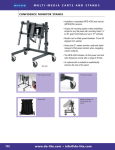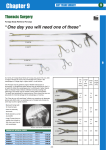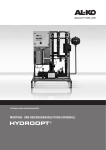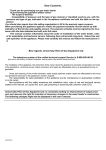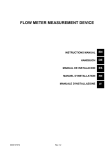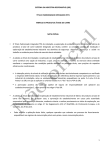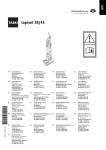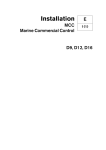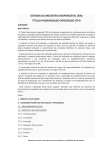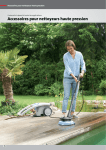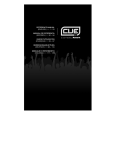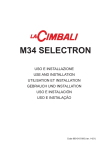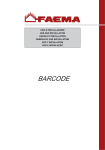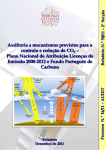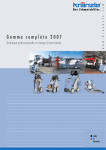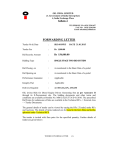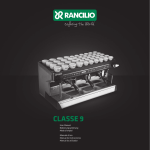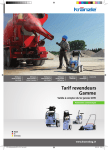Download Operating manual SKIT_S_DEB_SPS_4a
Transcript
Operation and Maint. instructions for the SKIT/S-DEB-SPS OWS 4. Edition V301102032 Page 1 Water Technology Operating and Maintenance Instructions Oily Water Separator SKIT/S-DEB a c c . I M O R e s o l u t i o n RWO GmbH • Marine Water Technology • Bremen • Germany M E P C . 1 0 7 ( 4 9 ) Issued: 20.09.2005 Operation and Maint. instructions for the SKIT/S-DEB-SPS OWS 4. Edition V301102032 Page 2 Contents 1. Safety................................................................................................................................................. 4 1.1. Risks involved in operating the oily water separator (OWS).................................................... 4 1.2. Safety information and tips ...................................................................................................... 4 1.3. Proper use................................................................................................................................ 4 1.4. Emissions ................................................................................................................................. 4 1.5. Sources of risk ......................................................................................................................... 5 2. Important technical notes................................................................................................................ 5 3. General .............................................................................................................................................. 7 3.1. Extract of IMO Resolution MEPC.107(49) ............................................................................... 7 3.2. Marpol 73/78 Annex I ............................................................................................................... 7 3.3. Regulation 16(5)....................................................................................................................... 7 3.4. The Resolution MEPC.107(49) ................................................................................................ 8 3.5. Equipment requirements .......................................................................................................... 8 3.6. Installation requirements .......................................................................................................... 9 3.7. Instructions............................................................................................................................... 9 3.8. Training .................................................................................................................................... 9 3.9. Applicability .............................................................................................................................. 9 3.10. Separator-friendly detergents/cleaners.................................................................................... 9 3.11. Type approval .......................................................................................................................... 9 4. Process description RWO oily water separator SKIT/S-DEB .................................................... 10 4.1. Oil Water Separation.............................................................................................................. 10 4.2. Description of the Adsorber operation mode ......................................................................... 10 4.3. Flushing.................................................................................................................................. 12 4.4. Bilge Alarm Monitor OMD 2005 ............................................................................................. 13 5. Operating the OWS SKIT/S-DEB ................................................................................................... 13 5.1. Before first commissioning ..................................................................................................... 13 5.2. Before every commissioning.................................................................................................. 15 5.3. Start up OWS SKIT/S-DEB .................................................................................................... 16 5.4. Information of the control LED´s of the OWS control panel, Table 3..................................... 17 5.5. Check list for commissioning and start up ............................................................................. 18 6. Maintenance.................................................................................................................................... 20 6.1. Regular checks ...................................................................................................................... 20 6.2. Every 6 months ...................................................................................................................... 20 6.3. Every year .............................................................................................................................. 20 7. Optional Alarms and Indications .................................................................................................. 20 8. Troubleshooting ............................................................................................................................. 21 8.1. Warnings ................................................................................................................................ 21 8.2. Fault table .............................................................................................................................. 21 9. Operating Instructions For Oily Water Separator Control Unit ................................................. 24 9.1. Generally:............................................................................................................................... 24 9.2. Operating Devices Of The Control Unit ................................................................................. 24 a) On – Off – Main Switch........................................................................................................ 24 b) Hand – 0 – Automatic Selector Switch ................................................................................ 24 c) Position Manual Operation .................................................................................................. 24 d) Position 0 (Zero) .................................................................................................................. 24 e) Position Automatic............................................................................................................... 24 f) On – Off – Switch Electrical Heating (Optional) .................................................................. 24 9.3. LED-Indication........................................................................................................................ 24 a) White LED (Power).............................................................................................................. 24 b) Red LED (Failure)................................................................................................................ 24 c) Red/Orange/Green LED (Status) ........................................................................................ 24 d) Green LED (Bilge Level)...................................................................................................... 24 9.4. Push Buttons.......................................................................................................................... 24 a) ESC-Button.......................................................................................................................... 24 b) – Button, + Button................................................................................................................ 25 c) Enter-Button ........................................................................................................................ 25 9.5. LCD-Display ........................................................................................................................... 25 9.6. Menu Tree.............................................................................................................................. 26 RWO GmbH • Marine Water Technology • Bremen • Germany Issued: 20.09.2005 Operation and Maint. instructions for the SKIT/S-DEB-SPS OWS 4. Edition V301102032 Page 3 a) Start Message ..................................................................................................................... 26 b) Operating Indication ............................................................................................................ 26 c) Display Indication Aroused By Menu Operations................................................................ 28 d) Language selection ............................................................................................................. 29 e) Input:.................................................................................................................................... 29 f) Output: ................................................................................................................................. 29 g) Branch To The Customer Parameters ............................................................................... 30 h) Changing The Customer Parameter ................................................................................... 31 9.7. Control Functions ................................................................................................................... 32 a) Oil Recognition and Oil Discharge ...................................................................................... 32 b) Additional Control Functions ............................................................................................... 32 c) Alarms.................................................................................................................................. 34 d) In Service Indication ............................................................................................................ 34 10.Copyright regulations .................................................................................................................... 34 11.Spare parts...................................................................................................................................... 35 11.1. Part list (see the attached drawings for Pos. no.) .................................................................. 35 11.2. Parts list automatic control panel ........................................................................................... 37 11.3. Ident numbers for parts built on the first stage OWS............................................................. 38 11.4. Ident numbers for valve and instruments spare parts............................................................ 39 11.5. Ident numbers for parts of the bilge alarm automatic stopping device .................................. 40 11.6. Ident numbers of the Adsorber .............................................................................................. 41 12.Drawings ......................................................................................................................................... 42 12.1. Adsorber (second stage)........................................................................................................ 42 12.2. Valve Pos. 4; Pos. 5 + Pos. 15 with SKIT S DEB 0.1 ... 5.0 m3/............................................ 43 12.3. Valve Pos. 4 / Pos. 5 only with SKIT S DEB 10 m3/h ............................................................ 44 12.4. Sensor Electrode (Pos. 9) ...................................................................................................... 45 12.5. Valve Pos. 23 + Pos. 58 with SKIT S DEB 0.1 .... 1.0 m3/h................................................... 46 12.6. Valve Pos. 23 and Pos. 58 with SKIT S DEB 1,5 ....2,5 m3/h............................................... 47 12.7. Valve Pos. 23 and Pos. 58 with SKIT S DEB 5,0 ....10,0 m3/h............................................. 48 12.8. Coalescer (Pos. 34) ............................................................................................................... 49 12.Record of routine and repair maintenance.................................................................................. 50 13.Outline drawing (see attached) ..................................................................................................... 51 14.Wiring diagram (see attached) ...................................................................................................... 51 Table list Table 1 type approval certificates .........................................................................................10 Table 2 Overview of the valves and their operation mode during the process ....................12 Table 3 Information of the control LED´s of the OWS control panel ....................................17 Table 4 Check list for commissioning and start up ...............................................................18 Table 5 Fault table ................................................................................................................21 Table 6 a Coalescer stage and integrated pipework up to Adsorber vessel ...........................36 Table 6 b Adsorber vessel .......................................................................................................36 Table 7 Parts list automatic control panel.............................................................................37 Table 8 parts for the first stage OWS ...................................................................................38 Table 9 Ident numbers for valve spare parts ........................................................................39 Table 9 Continuation of Ident numbers for valve spare parts...............................................40 Table 10 Ident numbers for parts of the bilge alarm automatic stopping device....................40 Table 11 Ident numbers of the Adsorber ................................................................................41 Table 12 Record of routine and repair maintenance ..............................................................50 RWO GmbH • Marine Water Technology • Bremen • Germany Issued: 20.09.2005 Operation and Maint. instructions for the SKIT/S-DEB-SPS OWS 1. 4. Edition V301102032 Page 4 Safety 1.1. Risks involved in operating the oily water separator (OWS) The OWS has been safety and certification tested. Incorrect operation or misuse involves risks to: • life and limb of service personnel • the OWS and other shipboard plant and • the efficient functioning of the OWS. All staff involved in commissioning, operating, servicing and maintaining the OWS must: • be properly qualified and • adhere to this User Information closely. It could save your life! 1.2. Safety information and tips The following symbols are used in this user manual: Indicates a direct potential danger. Failure to observe this warning can result in death or severe injury. Danger Voltage Hand injuries Tipping over Hot surface Indicates a possibly dangerous situation. A failure to observe this warning can result in damage to health, injury and/or damage to the oily water separator. Attention Indicates important information and necessary action. A failure to observe can result in damage to, or malfunction of, the oily water separator. Important Information Indicates tips for use or other useful information. 1.3. Proper use The OWS is intended to be used for the separation of bilge water consisting of dispersed oilwater mixtures and emulsified hydrocarbons in accordance with IMO requirements. The plant (or pump) may not be used to discharge oily sludge. Ecologically dangerous! Important 1.4. Emissions The oily water system has a continuous noise level below 70 dB(A). RWO GmbH • Marine Water Technology • Bremen • Germany Issued: 20.09.2005 Operation and Maint. instructions for the SKIT/S-DEB-SPS OWS 4. Edition V301102032 Page 5 1.5. Sources of risk Electric voltage > 42 V Direct contact with live parts may cause serious injury or death. Fixed connection to onboard mains should only be done by qualified staff (electricians) Danger Disconnect the power supply before working on electrical installations (switch off at the main switch, remove or switch off fuses). The OWS works with an eccentric screw pump. Do not touch the gear casing / stuffing box packing on the rotating shaft! Doing so risks severe injuries to the fingers. Attention The flushing water entry valve (Fig. 4, Pos. 4, 5 and 15) is closed by a tensed spring. Disassemble very carefully to avoid having the spring jump out and cause injury. Attention Attention 2. The OWS can be heated (either electrically or, e.g., by steam). Temperatures up to around 50°C can then obtain in the upper part, which could cause burns if touched. Important technical notes • An ows must be operated and maintained according to this Information if it is to operate reliably. • We are not liable for any damage arising from improper use, or installing or the disregarding of this Information. • The electrical connection values clearly displayed on the automatic-control box must be adhered to. • The ows is designed for a water mixture temperature between min. +2 and max. 45 C. Important The ows pump is designed for a maximum temperature of + 45 C. Temperatures above this lead to excessive motor starting torque due to material expansion in the rotating parts which could cause major damage to the motor. • The pump rotates to the right when viewed from the motor. During initial operation. incorrect rotation direction leads to the pump running dry and overheating can then destroy the stator after just a few revs Important • Compressed air (6 - 8 bar) and backwash water (1 bar, max. 1.5 bar) are needed to operate the ows. Water flow pressure should not be less than 0.5 bar. • The plant is to be kept free of solids. • Avoid emulsions! If absolutely unavoidable, use only separator-friendly cleaners recommended by RWO. • If the site is subject to frost, the plant must be completely emptied after every use or kept warm at all times. • Clean all pipelines and bilges before starting up for the first time. RWO GmbH • Marine Water Technology • Bremen • Germany Issued: 20.09.2005 Operation and Maint. instructions for the SKIT/S-DEB-SPS OWS 4. Edition V301102032 Page 6 • Use only original RWO spares in order to guarantee operating and functional safety (this is a pre-requisite of the IOPP Certificate, see Fig. 3.2). • Ensure safe, environment-friendly disposal in conformity with all applicable laws of all residues and waste after repair work.! Important contact numbers RWO Repair and Service Tel: 49-421-5370535 Fax: 49-421-5370540 RWO - Spares service Tel: 49-421-5370518 Fax: 49-421-5370540 RWO - Plant sales Tel: 49-421-5370512 Fax: 49-421-5370540 e-mail: [email protected] homepage: www.rwo.de IMPORTANT! Always state the ows plant number (see front page) RWO GmbH • Marine Water Technology • Bremen • Germany Issued: 20.09.2005 Operation and Maint. instructions for the SKIT/S-DEB-SPS OWS 3. 4. Edition V301102032 Page 7 General The IMO Resolution MEPC.107(49) has been adopted on 18th July 2004 and applies to all oily water separators and 15ppm alarm devices to be installed onboard ships on or after 1st January 2005. The IMO Resolution MEPC.107(49) describes in detail the type approval procedures for oily water separators and 15ppm oil content alarm devices. The main difference between the former MEPC.60(33) rule and the new MEPC.107(49) one, is the required performance compliance involving an oil-in-water emulsion. The emulsion is created by mixing the different test oils with a specified emulsifying chemical and a powder of iron oxide under controlled conditions for one hour by means of a high speed centrifugal pump. The oily water separator must then be able to breakdown the emulsion and extract the oily residues. An emulsion is a mixture of two or more components. In this application it involves oil and water. In this mixture the oil particle is still present, but does not form droplets and larger agglomerations. It requires mechanical energy to make an emulsion i.e. a high pressure water jet, high speed centrifugal pumps, all of which are transforming the oil droplets into very small particles. This type of mechanical emulsion can easily be handled by an efficient coalescer, but in the presence of an emulsifying chemical the oil particle becomes hydrophob by ionic and anionic tensides on the oil particle surface. The same micro electric load of all particles in a stable chemical emulsion makes the agglomeration impossible. Mechanical emulsions can normally be separated by mechanical coalescers, however stable chemical emulsions can not be handled by a coalescer because the surface active compounds on the coalescer surface prevent the coalescing effects of the coalescer material. Stable chemical emulsions can be split by means of: • • • • heat treatment i.e. evaporation chemically, by using adequate flocculents membrane – ultrafiltration, which retains the oil molecules Absorption by suitable materials 3.1. Extract of IMO Resolution MEPC.107(49) Revised Guidelines and Specification for Pollution Prevention Equipment for Machinery Space Bilges of Ships: 3.2. Marpol 73/78 Annex I The requirements of Annex I of the International Convention for Prevention of Pollution from Ships MARPOL 73/78 relating to pollution prevention equipment for ships are set out in regulation 16, which stipulates that ships of 400 gross tonnage and above should be installed with approved equipment. 3.3. Regulation 16(5) Regulation 16(5) stipulates that the oil content of the from 15 ppm Bilge Separators should not exceed 15 ppm. The 15 ppm Bilge Alarm shall activate to indicate when this level cannot be maintained, and initiate automatic stop of overboard discharge of oily mixtures where applicable. 3.3.1 15 ppm Bilge Separator 3.3.2 15 ppm Bilge Alarm 3.3.3 Automatic stopping device RWO GmbH • Marine Water Technology • Bremen • Germany Issued: 20.09.2005 Operation and Maint. instructions for the SKIT/S-DEB-SPS OWS 4. Edition V301102032 Page 8 3.4. The Resolution MEPC.107(49) The Resolution MEPC.107(49) supersedes the recommendations contained in Resolution MEPC.60 (33). 3.5. Equipment requirements 3.5.1 Bilge The Resolution MEPC.107(49) separator 15 ppm Bilge Separators are considered to be applicable for use in conjunction with oily bilgewater and ballast water from fuel oil tanks, as these are of a low or medium capacity, and are conditioned by the need to avoid discharging oil mixtures with an oil content more than 15 ppm of the mixture. It should be understood that a 15 ppm Bilge Separator must be capable of handling any oily mixtures from the machinery space bilges and be expected to be effective over the complete range of oils which might be carried on board ship, and deal satisfactorily with oil of very high relative density, or with a mixture presented to it as an emulsion. Cleansing agents, emulsifiers, solvents or surfactants used for cleaning purposes may cause the bilge water to emulsify. Proper measures should be taken to minimize the presence of these substances in the bilges of a ship. With the possibility of emulsified bilge water always present the 15 ppm Bilge Separator must be capable of separating the oil from the emulsion to produce an effluent with an oil content not exceeding 15 ppm. 3.5.2 Bilge Alarm The 15 ppm Bilge Alarm should record date, time and alarm status, and operating status of the 15 ppm Bilge Separator. The recording device should also store data for at least eighteen months and should be able to display or print a protocol for official inspections as required. In the event the 15 ppm Bilge Alarm is replaced, means should be provided to ensure the data recorded remains available on board for 18 months (computer unit). To avoid wilful manipulation of 15 ppm Bilge Alarms, the following items should be included: 1. every access of the 15 ppm Bilge Alarm beyond the essential requirements of paragraph 4.2.8 requires the breaking of a seal; and 2. the 15 ppm Bilge Alarm should be so constructed that the alarm is always activated whenever clean water is used for cleaning or zeroing purposes. 3.5.3 Automatic Stopping Device The automatic stopping device is a device used, where applicable, to automatically stop any discharge overboard of oily mixture when the oil content of the effluent exceeds 15 ppm. The automatic stopping device should consist of a valve arrangement installed in the effluent outlet line of the 15 ppm Bilge Separator which automatically diverts the effluent mixture from being discharged overboard back to the ship's bilges or bilge tank when the oil content of the effluent exceeds 15 ppm. The accuracy of the 15 ppm Bilge Alarms should be checked at IOPP (International Oil Pollution Prevention) Certificate renewal surveys according to the manufacturers instructions. Alternatively the unit (measuring block) may be replaced by a calibrated 15 ppm Bilge Alarm. The calibration certificate for the 15 ppm Bilge Alarm, certifying date of last calibration check, should be retained onboard for inspection purposes. The accuracy checks can only be done by the manufacturer or persons authorized by the manufacturer RWO GmbH • Marine Water Technology • Bremen • Germany Issued: 20.09.2005 Operation and Maint. instructions for the SKIT/S-DEB-SPS OWS 4. Edition V301102032 Page 9 3.6. Installation requirements 15 ppm Bilge Separator For future inspection purposes on board ship, a sampling point should be provided in a vertical section of the water effluent piping as Fig. 1 nach Außenbord close as is practicable to the 15 ppm Bilge Separator outlet. Re-circulating zur Bilge Automatikfacilities (manual 3 way valve) should be Rezirkulation Einrichtung für stoppprovided, after and adjacent to the Test- und Hafenkontrollbehörde einrichtung overboard outlet of the stopping device to zur Bilge enable the 15 ppm Bilge Separator system, including the 15 ppm Bilge Alarm 15 ppm and the automatic stopping device, to be Bilge Alarm Entöler tested with the overboard discharge closed (see Fig. 1). The re-circulating facility should be so configured as to prevent under all operating conditions any by-ass of the oily-water-separator. 15 ppm Bilge Separator should be based in a non-hazardous area. 3.7. Instructions A vessel fitted with a 15 ppm Bilge Separator should, at all times, have onboard a copy of the Operating and Maintenance manuals. All routine and repair maintenance to be recorded, see section 12. “Routine and repair maintenance record”. 3.8. Training Ship staff training should include familiarization in the operation and maintenance of the equipment. 3.9. Applicability These guidelines and specifications apply: • to installations fitted to ships, the keel of which are laid or which are at a similar stage of construction on or after 1 January 2005 and • to new installations fitted on or after 1 January 2005 to ships, the keel of which were laid or which were at a similar stage construction before 1 January 2005 in so far as is reasonable and practicable 3.10. Separator-friendly detergents/cleaners Detergents often transform oil-water mixtures into stable emulsions not separable by gravity and coalescence. We have performed exhaustive detergent tests on our plant under field conditions. Several of the multitude of products available on the market were tested, and those listed below proved relatively good when used on our plant: 1. Drewclean 2000, Drew Ameroid Marine Division Ashland Chemical, Inc 2. Tegeral Des Flüssig, Tegee-Chemie GmbH 3. Tegeral Forte, Tegee-Chemie GmbH 4. Carclin Außenreiniger F, Henkel KGaA 5. Carclin Veri, Henkel KGaA 3.11. Type approval The type approval for the 15 ppm bilge separator and for the 15 ppm bilge alarm with automatic stopping device has been carried out satisfactory accordance with the Annex of the Resolution MEPC 107.(49). Part 1 - Test and performance specifications for type approval of 15 ppm bilge separators Part 2 - Test and performance specifications for type approval of 15 ppm bilge alarms Part 3 - Specifications for environmental testing for type approval of pollution prevention equipment RWO GmbH • Marine Water Technology • Bremen • Germany Issued: 20.09.2005 Operation and Maint. instructions for the SKIT/S-DEB-SPS OWS 4. Edition V301102032 Page 10 Part 4 - Method for the determination of the oil content Part 5 - Documentation of approval APPENDIX 1 – Certificate of type approval for 15 ppm bilge separator APPENDIX 2 – Certificate of type approval for 15 ppm bilge alarm The following type approval certificates are available: EC-conformity acc. to Marine Equipment Directive MED 96/ 98/ EC as amended by Directive 2002/75/EC National Certificate Germany National Certificate USA National Certificate Canada National Certificate Russia Acceptance Confirmation USA Table 1 4. Entöler SKIT/S DEB 0,1.....10 m3/h Bilge Alarm OMD-2005 Module B Module D Production Quality Assurance SBG Module B Module F SBG USCG CCG RMRS RMRS USCG USCG type approval certificates Process description RWO oily water separator SKIT/S-DEB The RWO oily water separation system type SKIT/S-DEB complies with the recent IMO Resolution MEPC.107(49), using the combination of a highly effective open porous coalescer, the well known RWO oily water separator SKIT/S, together with a second stage newly developed emulsion breaking oil and hydrocarbon absorber. 4.1. Oil Water Separation The oily water is drawn from the bilge through the separator by an eccentric helical rotor pump, so that an additional mixture of oil and water is avoided. As a result of the excellent homogeneous fluid mechanics in the oily water separator and the difference of density between oil and water the rough separation of oil takes place immediately by gravity flowing through the built-in modem coalescer which is a very open-porous type, smallest oil droplets are separated by the extremely oleophilic surface. This system features the outstanding efficiency of the SKlT/S oily water separator. 4.2. Description of the Adsorber operation mode The operation mode is controlled by the Bilge Alarm Monitor OMD 2005 (P&ID 514 00 005, see enclosure). The oil collection capacity of the Adsorber elements is limited by the collected oil quantity. To protect the Adsorber elements and extent the lifetime, the Adsorber is fitted with an upstream 3-way bypass valve (Pos. 58) which makes it possible that the water, purified by the OWS, showing an oil content of less than 14ppm will bypass the Adsorber and will be discharged overboard. RWO GmbH • Marine Water Technology • Bremen • Germany Issued: 20.09.2005 Operation and Maint. instructions for the SKIT/S-DEB-SPS OWS 4. Edition V301102032 Page 11 The demulsifier has a certain absorption capacity. The Adsorber elements remove all kind of hydrocarbons from the water. The Adsorption capacity is mainly limited by the quantity of hydrocarbons solved or emulsified in the water, but also dirt particles in large quantities might clog the Adsorber. To prolong the lifetime of the Adsorber, heavy emulsions with high oil percentage should be avoided by using quick separating cleaners in the engine room. Cleaning emulsion of the aircoolers or purifier sludge should be avoided in the bilge. Only if the oil content in the treated water, after the first stage OWS / before the Adsorber (sample point α) is showing an oil content higher or equal than 14ppm, the water will flow through the Adsorber and the oil content in the effluent will be measured at a second measuring point (sample point β) after the Adsorber. If the oil content is below 15ppm the water will be discharged overboard. To investigate the performance of the first stage OWS continuously and to protect the Adsorber, every 5 minutes a sample is taken from sample point α for 4 seconds to check the actual oil content. If the oil content will be below 14ppm again, the 3-way bypass valve (Pos. 58) will change to Adsorber bypass. If the oil content after the OWS is still higher or equal than 14ppm the water flow remains via the Adsorber for the next 5 minutes. During this short investigation procedure (4 seconds) the 3-way diverting valve (Pos. 23) will change to recirculation to the bilgewater tank. If the oil content even after the Adsorber will be higher than 15ppm the water will be recirculated by the 3-way diverting valve (Pos. 23) to the bilgewater tank. The limiting values of the oil content in the effluent water after the first stage OWS and after the Adsorber might be adjusted to each value between 0 - 15ppm. Ex factory the limiting values are 14ppm at sample point α and 15ppm at sample point β. Only if the oil content of 15ppm after the Adsorber is exceeded for at least 3 seconds an alarm to the control room will be activated. The Alarm 2 (sample point α) must be lower than Alarm 1 (sample point β). Basically three different signals conditions can occur on the control panel: Both limiting values are undershoot (sample point α under 14ppm and sample point β under 15ppm). OPERATION MODE ADSORBER BYPASS LED lights green at the control panel on the switching box. The 3-way bypass valve (Pos. 58) (solenoid valve energised) bypassed the water at the Adsorber and convey it directly to the 3-way diverting valve (Pos. 23). The 3-way sample valve (Pos. 57) convey the sample water at the sample point β to the Bilge Alarm Monitor OMD 2005 (solenoid valve energised). The 3-way diverting valve (Pos. 23) convey the water overboard (solenoid valve energised). Limiting value Alarm 2 is exceeded (sample point α over or equal 14ppm) and limiting value Alarm 1 is undershoot (sample point under 15ppm). OPERATION MODE VIA ADSORBER LED lights green at the control panel on the switching box. The 3-way bypass valve (Pos. 58) (solenoid valve energised) convey the water through the Adsorber. The 3-way sample valve (Pos. 57) convey the sample water at the sample point β to the Bilge Alarm Monitor OMD 2005 (solenoid valve de-energised). The 3-way diverting valve (Pos. 23) convey the water overboard (solenoid valve energised). In this situation mode, every 5 minutes the concentration of residual oil will be measured before of the Adsorber (at the sample point α) for 4 seconds. The 3-way sample valve (Pos. 57) will be switched temporary to the sample point α. During this short measuring period the 3way diverting valve (Pos. 23) will be switched to recirculation (solenoid valve de-energised). If the measurement result a concentration of residual oil below the first limiting value, the condition b) will switched on. RWO GmbH • Marine Water Technology • Bremen • Germany Issued: 20.09.2005 Operation and Maint. instructions for the SKIT/S-DEB-SPS OWS 4. Edition V301102032 Page 12 Both limiting values are exceeded. OPERATION MODE VIA ADSORBER LED lights green at the control panel on the switching box. The 3-way bypass valve (Pos. 58) convey the water through the Adsorber (solenoid valve deenergised). The 3-way sample valve (Pos. 57) in the measuring pipe convey the sample water at the sample point to the Bilge Alarm Monitor OMD 2005 (solenoid valve de-energised). The 3-way diverting valve (Pos. 23) convey the water back to the bilgewater tank (solenoid valve de-energised). The alarm signal in the switching box is activated. Overview of the valves and their operation mode during the process Signal mode of the Valve Bilge Alarm Monitor Pos. OMD 2005 Description Valve Position / Function Solenoid valve a) Oil content below 14ppm after OWS (sample point α). 57 3-way sample valve Sample point α (before of the Adsorber) Energised 23 3-way diverting valve To overboard Energised 58 3-way bypass valve Adsorber bypass Energised b) Sample point α (ex factory set 14ppm) exceeded but sample point β is below 15ppm. 57 3-way sample valve Sample point β (after the Adsorber) De-energised 23 3-way diverting valve To overboard Energised 58 3-way bypass valve Via the Adsorber De-energised During the situation mode b), the system is checking periodically every 5 minutes the oil content at sample point α. This procedure takes only few seconds. 57 3-way sample valve Sample point α (before of the Adsorber) Energised 23 3-way diverting valve Back to the bilge water tank De-energised 58 3-way bypass valve Via the Adsorber De-energised c) Both limiting values are exceeded. 57 3-way sample valve Sample point β (after the Adsorber) De-energised 23 3-way diverting valve Back to the bilge water tank De-energised 58 3-way bypass valve Via the Adsorber De-energised Table 2 Overview of the valves and their operation mode during the process 4.3. Flushing The separated oil flows upwards and is collected on the surface. A powerful electric heating supports the separation. The oil-level is detected by the RWO-sensor unit. Immediately after discharging the oil the time-controlled flushing is started. Clean water is used for flushing. The coalescer is cleaned from oil and dirt by periodical flushing. The mixture of oil sludge and water is drained off to the bilge. The fully automatic oil discharge- and flushing-cycle is a special feature of the SKlT/S oily water separator. The periodic flowreverse enables continuous operation without clogging of the coalescer which cleans itself while operating. RWO GmbH • Marine Water Technology • Bremen • Germany Issued: 20.09.2005 Operation and Maint. instructions for the SKIT/S-DEB-SPS OWS 4. Edition V301102032 Page 13 4.4. Bilge Alarm Monitor OMD 2005 The oily water separating system is equipped with the 15ppm oil content alarm device OMD 2005, type tested and approved in accordance with IMO Resolution MEPC.107(49). The new resolution requires: The 15 ppm Bilge Alarm should record date, time alarm status and operating status of the 15 ppm Bilge Separator. The recording device should also store data for at least eighteen months and should be able to display or print a protocol for official inspections as required. In the event that the 15 ppm Bilge Alarm is replaced, procedures should be put in place to ensure the recorded data remain accessible on board for 18 months. To prevent tempering with the 15 ppm Bilge Alarms, the following precautions should be taken: • Every access of the 15ppm Bilge Alarm beyond the essential requirements of paragraph 4.2.8 of the MEPC.107(49), requires the breaking of a seal. • The 15 ppm Bilge Alarm should be so constructed that the alarm is always activated whenever clean water is used for cleaning or zeroing purposes. The Bilge Alarm Monitor OMD 2005 complies with the above rules. The measuring cell can be removed for calibration while the control device remains on the oily water separator to keep the recorded data on board for at least 18 months. According to IMO Resolution MEPC.107(49) a 3-way valve must be installed downstream of the oily water separator in the overboard line to recirculate the water to the bilge during “port” state control procedure. As automatic stopping device a 3-way diverting valve is installed downstream and if the oil content in the effluent exceeds 15ppm the 3-way diverting valve will change over to recirculation and the alarm to the engine room control system is activated. 5. Operating the OWS SKIT/S-DEB 5.1. Before first commissioning • 5.1.1 Check electrical connections Danger Electrical voltage > 42 V Direct contact with live parts may lead to severe injury or death. Fixed connections to the onboard mains may only be installed by qualified staff (electricians). Risk of explosion. Standard plant may not be operated in hazardous areas. Danger • 5.1.2 Service pipe and all flange connections Compressed-air connections, backwash water connections and all flange connections must be checked for tightness. Tighten both of OWS cover if necessary. Pressurised piping is dangerous. Release the pressure completely before working on them. RWO GmbH • Marine Water Technology • Bremen • Germany Issued: 20.09.2005 Operation and Maint. instructions for the SKIT/S-DEB-SPS OWS 4. Edition V301102032 Page 14 Attention Impotant The oily water separator SKIT/S-DEB is a suction type. Ensure that the OWS does not suck air via leaks in the suction piping and/or flange connections the OWS. Sucking air initiates endless periodical discharge and flushing, which means the OWS cannot suck wastewater and therefor cannot separate water and oil as required. RWO GmbH • Marine Water Technology • Bremen • Germany Issued: 20.09.2005 Operation and Maint. instructions for the SKIT/S-DEB-SPS OWS 4. Edition V301102032 Page 15 • 5.1.3 Check if bilge water is available The "LEVEL" LED is a visual display of availability of bilge water. The OWS is equipped ex works with two bridges between the clamps X2-4 and X2-5 as well as X2-6 and X2-7 in the control panel. The OWS can only be started when bridged or if connected to two level switches (high and low level) in the bilge water tank for automatic operation. Impotant We recommend to replace these bridges by two level switches ( 1pc high level and 1pc low level switch) in the bilge or in the bilge water tank and to control the plant by the level switches depending to the bilge water level. Therefor both level switches must work with closing contacts. The plant only starts if the water level rise and the contacts of both level switches are closed. The plant stops if the water level falls and the contacts of both level switches are open. 5.2. Before every commissioning • 5.2.1 Check if bilge water is available. The "LEVEL" LED is a visual display of availability of bilge water. See a detailed description under point 5.1.3 Impotant • 5.2.2 Guarantee compressed-air and backwash water. • 5.2.3 Open all valves in the sucking line. • 5.2.4 Open all valves in the suction and discharge pipes. This is a positive displacement pump. Do not run the pump against a closed valve Impotant RWO GmbH • Marine Water Technology • Bremen • Germany Issued: 20.09.2005 Operation and Maint. instructions for the SKIT/S-DEB-SPS OWS 4. Edition V301102032 Page 16 5.3. Start up OWS SKIT/S-DEB Electric voltage > 42 V Direct contact with live parts may cause serious injury or death. Fixed connection to onboard mains should only be done by qualified staff (electricians) Danger Disconnect the power supply before working on electrical installations (switch off at the main switch, remove or switch off fuses). Fig. 2 RWO Water Technology By 4 LED's in the control box door the basic functions are shown. The OWS can be started with a main switch and the operating mode can be chosen with a switch "hand-0auto" Clamps for two level switches in the bilge are available to start or stop the OWS in the automatic operation mode by level switch. Bremen - Germany RWO WATER TECHNOLOGY VERSION ....... Esc POWER FAILURE STATUS BILGE LEVEL GREEN - WATER DISCHARGE RED OIL DISCHARGE ORANGE - FLUSHING Fig 2 heater The terminals of the swimmer switches are ex works bridged. hand 0 auto I main switch 0 ON HAND AUTO 0 0 OFF OFF Fig. 2 shows the control panel: • Make the decision whether to work in the manual or automatic mode. Information In the manual mode the plant will work independent of the signals from the bilge water level switches. A level dependent stop of the plant isn’t carried out. Therefore this operating mode should be selected only under permanent supervision. • Switch on the main switch. • The status LED is red illuminated (oil discharge to collecting tank), because the sensor electrode reports air like oil (both are non conducting mediums). The pneumatic piston valves at the flushing water inlet (pos. 15) and at the oil outlet (pos. 4) are open (both solenoid valves are energised) and the plant is simultaneously filled with flushing water and vented automatically. At this procedure the pump is shut down. • If the water level reach the sensor electrode (pos. 9) (conductive medium is regonized), the status LED is orange illuminated (flushing). The pneumatic piston valve (pos. 5) is open (the solenoid valve is energised) and with a time delay the oil outlet valve (pos. 4) is closing (the solenoid valve is not energised). • If the system is filled up, both piston valves (pos. 5 and 15) are closed (both solenoid valves are not energised). The status LED is green illuminated (water discharge). Now the pump starts and sucks from the bilge. The plant is now ready for operation. • Now the heating can be switched on by the switch “heater”. RWO GmbH • Marine Water Technology • Bremen • Germany Issued: 20.09.2005 Operation and Maint. instructions for the SKIT/S-DEB-SPS OWS 4. Edition V301102032 Page 17 5.4. Information of the control LED´s of the OWS control panel, Table 3 Description POWER Colour white Condition Main switch "On" Meaning / cause The power supply is enable the plant is energised red One or more alerts The alarm cause is shown on the display as FAILURE are online a text The level switches in Indication of bilge water level! If no level BILGE LEVEL green the bilge or bilge switches attached to the corresponding terwater tank signals minals the terminals must be bridged other“bilge water are wise the plant cannot start in the automatic available” mode. See chapter 5.1.3 Check if bilge water is available. green OWS in operation Cleaned water is pumped out STATUS GREEN WAThe display points WATER DISTERCHARGE DISCHARGE red OWS in operation Oil or air is discharged to the oil collecting RED-OILThe display points tank DISCHARGE OIL DISCHARGE The pump and the heater are switched off Valve 4 and 15 are open ORANGEorange OWS in operation The back flushing procedure is running FLUSHING The display points The pump and the heater are switched off FLUSHING Valve 4 and 15 are open Table 3 Information of the control LED´s of the OWS control panel In the chapter 9. you find a detailed description of the OWS control box with microprocessor You find on the following two sides a check list for commissioning and start up Follow this list point for point. RWO GmbH • Marine Water Technology • Bremen • Germany Issued: 20.09.2005 Operation and Maint. instructions for the SKIT/S-DEB-SPS OWS 4. Edition V301102032 Page 18 5.5. Check list for commissioning and start up Table 4 Check list for commissioning and start up Test Procedure Remarks Open valves for compressed air supply. Open valves for flushing water supply. Open valves in the suction line from bilge tank. Air pressure 6-8 bar. Water pressure 1,0 bar. Ensure that the OWS does not suck air via leaks in the pipe system. CAUTION: Never operate against close valve. CAUTION: Wrong rotating direction will damage the stator. Ventilation Open valves in the overboard discharge line. Check rotation direction of the pump (see arrow mark, clock wise seen from the motor end). Vent valve for Adsorber open. Cut the plastic nipples from all pressure gauges. Check that the ventilation hole of the filling screw of the gear is open (elec.-motor gear). Ensure that bilge water is available Make the decision whether to work in the manual or automatic mode. Switch on POWER 1Q1 a) The bilge level LED is only green illuminated if the bilge level has reached the upper level switch b) The status LED is red illuminated (oil discharge to collecting tank), because the sensor electrode reports air like oil (both are non conducting mediums). The pneumatic piston valves at the flushing water inlet (pos. 15) and at the oil outlet (pos. 4) are open (both solenoid valves are energised) and the plant is simultaneously filled with flushing water and vented automatically. At this procedure the pump is shut down. c) If the water level reach the sensor electrode (pos. 9) (conductive medium is regonized), the status LED is orange illuminated (flushing). The pneumatic piston valve (pos. 5) is open (the solenoid valve is energised) and with a time delay the oil outlet valve (pos. 4) is closing (the solenoid valve is not energised). d) If the system is filled up, both piston valves (pos. 5 and 15) are closed (both solenoid valves are not energised). The status LED is green illuminated (water discharge). Now the pump starts and sucks from the bilge. The water is guided by the by-pass valve (pos. 58) to the 2nd part (adsorber) The water is guided by the measuring valve (pos. 57) from the measuring point behind the 2nd part to the bilge alarm monitor. Monitor OMD 2005 alarm 1 is red "On" Monitor OMD 2005 alarm 2 is red "On" RWO GmbH • Marine Water Technology • Bremen • Germany In the manual mode there is no automatic stop if the bilge is empty. It is a precondition for a plant start in the automatic mode The plant is filled up with water. The pump and the heater are now shut down. display indication in automatic mode OPERATION AUTO OIL DISCHARGE display indication in manual mode OPERATION HAND OIL DISCHARGE The back flushing procedure starts (8 up to 50 seconds) The pump and the heater are now shut down. display indication in automatic mode OPERATION AUTO FLUSHING display indication in manual mode OPERATION HAND FLUSHING The 1st part is now ready for operation. The pump and the heater are now switched on. Precondition is that you have set the heater switch to “on”. display indication automatic mode OPERATION AUTO WATER DISCHARGE display indication manual mode OPERATION HAND WATER DISCHARGE The solenoid valve is not energised The solenoid valve is not energised Air is in the measuring cell Air is in the measuring cell Issued: 20.09.2005 Operation and Maint. instructions for the SKIT/S-DEB-SPS OWS 4. Edition V301102032 Page 19 Test Procedure Remarks Monitor OMD 2005 system is red. The water is routed by the re-circulation valve (pos. 23) back to the bilge. The 2nd part (adsorber) is filled up Close the venting valve at the adsorber cover. During the first 5 minutes: The water is routed by the by-pass valve (pos. 58) to the 2nd part (adsorber). The water is routed from the measuring point behind the adsorber to the monitor by the measuring valve (pos. 57). Monitor OMD 2005 alarm 1 is green “off”. Monitor OMD 2005 alarm 2 is green “off”. Monitor OMD 2005 system is green. The cleaned water is routed to overboard by the recirculation valve (pos. 23). After the first 5 minutes: a) If the measurement underrun 14ppm at the measuring point before the adsorber. The water is routed by the by-pass valve (pos. 58) to pass the adsorber. The water is routed from measuring point before the adsorber to the monitor by the measuring valve (pos. 57). Monitor OMD 2005 alarm 1 is green “off”. Monitor OMD 2005 alarm 2 is green “off”. Monitor OMD 2005 system is green. The cleaned water is routed to overboard by the recirculation valve (pos. 23). b) If the measurement exceed 14ppm at the measuring point before the adsorber. Monitor OMD 2005 alarm 1 is red “on”. The monitor reacts to air with an alarm. The solenoid valve is not energised The measuring valve (pos. 57) is switched over. Now the water is routed from the measuring point after the adsorber to the monitor. The by-pass valve (pos. 58) is switched over. The water is now routed through the adsorber. Monitor OMD 2005 alarm 1 is green “off”. Monitor OMD 2005 alarm 2 is green “off”. Monitor OMD 2005 system is green. The cleaned water is routed to overboard by the recirculation valve (pos. 23). c) If the measurement exceed 15ppm at the measuring point after the adsorber. Monitor OMD 2005 alarm 1 is red “on”. Monitor OMD 2005 alarm 2 is red “on”. Monitor OMD 2005 system is red “alarm”. The water is routed from the measuring point after the adsorber to the monitor by the measuring valve (pos. 57). The water is routed through adsorber by the by-pass valve (pos. 58). The not sufficient cleaned water is routed back to the bilge by the re-circulation valve (pos. 23). Table 4 Check list for commissioning and start up RWO GmbH • Marine Water Technology • Bremen • Germany The solenoid valve is not energised The solenoid valve is not energised Clean water is in the measuring cell Clean water is in the measuring cell The monitor signals “no alarm” The solenoid valve is energised The solenoid valve is energised The solenoid valve is energised Clean water is in the measuring cell Clean water is in the measuring cell The monitor signals “no alarm” The solenoid valve is energised Water with more then 14ppm is in the measuring cell The solenoid valve is not energised The solenoid valve is not energised Clean water is in the measuring cell Clean water is in the measuring cell The monitor signals “no alarm” The solenoid valve is energised Alarm The adsorber elements are exhausted Water with more then 15pm is in the measuring cell Water with more then 15ppm is in the measuring cell The solenoid valve is not energised The solenoid valve is not energised The solenoid valve is not energised Issued: 20.09.2005 Operation and Maint. instructions for the SKIT/S-DEB-SPS OWS 6. 4. Edition V301102032 Page 20 Maintenance 6.1. Regular checks • Check difference pressure before and after the coalescer (pressure gauges Pos. 7 and Pos. 54). Max. difference pressure 0,2 bar. - back flushing the coalescer Information - Werden die Tasten (+) und (-) gleichzeitig für mind. 2 Sekunden gedrückt, wird eine Ölsimulation gestartet. Nach dem die Tasten los gelassen werden startet die Spülung. If this doesn't lead the desired success, the coalescer must be changed. • Check difference pressure before and after the Adsorber (pressure gauges Pos. 7 and Pos. 54). Max. difference pressure 3,0 bar. - exchange the Adsorber elements • Check stuffing box packing of the pump shaft. - Slight leakage welcome - intensive leakage => => tighten the stuffing box exchange the stuffing box packing • Check the difference pressure at the pump suction pressure side (pressure gauge Pos. 8 and Pos. 54) - Check the motor and stator - Replace worn elements 6.2. Every 6 months • Check the zinc anodes • Lubricating oil of the pump's gear motor => if necessary refill 6.3. Every year • Open the handhole, open the OWS and the Adsorber • Check if there is sedimented slugde => remove and clean • Check the inside coating => repaint if necessary • Check gaskets of the piston valves • Electrode: Clean the electrode if there is any damage => replace • Heating coil: Check the function 7. Optional Alarms and Indications • · see detailed instruction of OWS microprocessor controller RWO GmbH • Marine Water Technology • Bremen • Germany Issued: 20.09.2005 Operation and Maint. instructions for the SKIT/S-DEB-SPS OWS 8. 4. Edition V301102032 Page 21 Troubleshooting 8.1. Warnings Electric voltage > 42 V. Direct contact with live parts may cause serious injury or death. Work on live parts should only b e carried out by qualified electricians. Danger Pressurised piping is dangerous. Check and make sure that pipes are unpressurised before working on them. Attention Attention The OWS uses an eccentric screw pump. Do not touch the gearing casing or stuffing box packing whilst the shaft is turning as this may cause serious injury to the fingers. The flushing inlet valve is spring-loaded. Disassemble very carefully to avoid injury from the spring. Attention The OWS can be heated (electrically, by steam or by thermal oil). This leads to temperatures up to 60 C in the upper part, which should not be touched to avoid burns. Attention 8.2. Fault table Table 5 Fault table Fault Cause Remedy Constant rapid repetition of the backwashing process. OWS is sucking air from empty bilge. Level switch doesn’t initiate shutdown. Plant is sucking air through leaks in the suction piping or at the OWS (covers, flanges, valves). Shut off the OWS, check level switches. Suction piping or inlet basket filter clogged. Valves in suction piping closed Coalescer packing clogged. Clean or both. Motor burned Short-circuit, motor or power supply wiring Protection switch maladjusted Replace Check both Constant repetition of backwashing process and vacuum manometer shows too low a suction height proportionate to the installation level Low pumping performance at high vacuum reading Low pumping performance, several meters pressure difference between pump vacuum manometer and ditto on OWS cover. Motor protection switch trips RWO GmbH • Marine Water Technology • Bremen • Germany Pressure-test of the ows and suction piping, tighten al flanges. Open them Thoroughly manual flush by using the “simulation” button. If unsuccessful, replace coalescer. Correct setting Issued: 20.09.2005 Operation and Maint. instructions for the SKIT/S-DEB-SPS OWS Fault 4. Edition Cause Remedy Pump rotor stuck Find cause. Replace stator and/or rotor. Loosen stuffing box Pump shaft stuck Piston valves not functioning No compressed air supply Control voltage not available Piston ring defective Dirt in solenoid valve Defective solenoid valve Plant flushes constantly or unusually slowly Plant recognises oil but discharges water via the oil discharge V301102032 Page 22 Pistons stuck Inlet non-return inlet valve not closing Oil outlet clogged Backwash water pressure inadequate Wiring from switchbox to electrode interrupted Check compressed air supply Check automatic control panel Replace cylinder Clean Check by turning main switch ON and OFF. (Function can be felt and heard) Loosen them Check, remove and clean if necessary Check and clean Check water flow pressure. Min. is 0.5 bar, max. is 1 bar. Check and renew if needed Electrode insulated PC Board defective Plant recognises oil but does not discharge Plant doesn’t flush Plant doesn’t recognise oil Clean contact surfaces Bridge clamps X2-3 , if water is not recognised LED GREEN WATER illuminates green if PC-board is OK. Change PC-board if not. Oil outlet to oil collecting tank Check piping to collector blocked tank and clean if needed Backwash water supply inter- Check water supply rupted Check piston valve Pos. 15 Piston valve (Pos. 4 or 15) Check connection voltage doesn’t work in automatic-control box; should be 24 V between clamps X1-9/10 and X111/12. If not, change PCboard. Backwash water outlet to bilge Remove blockage (Pos. 5) blocked Piston valves (Pos. 5) and Check connection voltage (Pos. 15) don’t work in automatic-control box; should be 24 V between clamps X1-9/10 and X111/12. If not, change board. Wiring between sensor electrode and control box PC-board defect RWO GmbH • Marine Water Technology • Bremen • Germany Check wiring Check PC-board by removing the plug from the electrode (Pos. 9); if no oil recognition follows, replace Issued: 20.09.2005 Operation and Maint. instructions for the SKIT/S-DEB-SPS OWS Fault 4. Edition Cause V301102032 Page 23 Remedy the PC-board. Fault No heating Control voltage not available Cause Electrical conductivity in the oil phase too high or emulsions Remedy Avoid emulsions. Contact RWO Service dept. Oil binds water Heating element defect Wiring connection interrupted Thermal sensor maladjusted or defective Heating fuse U/S Transformer fuse if 24 V AC are not available between clamps X1-7/8 Wiring connection interrupted Board U/S Contact RWO Service dept. Replace Check and renew if needed Adjust to 45° C or replace RWO GmbH • Marine Water Technology • Bremen • Germany Replace Change fuse/s; if no cure, find cause. Renew wiring Check; 24 V must be available between clamps X29/10 and X2-13/14 when „RED-OIL-DISCHARGE“ illuminated Issued: 20.09.2005 Operation and Maint. instructions for the SKIT/S-DEB-SPS OWS 9. 4. Edition V301102032 Page 24 Operating Instructions For Oily Water Separator Control Unit 9.1. Generally: The OWS control unit will be operated by 4 push buttons. The LCD display has 2 backlighted lines of text each with 20 alphanumeric digits. Basic functions are indicated by 4 LED’s. 9.2. Operating Devices Of The Control Unit a) On – Off – Main Switch Enable / disable the power supply of the oily water separator. b) Hand – 0 – Automatic Selector Switch Switches the oily water separator from manual over stop to the automatic operation mode. c) Position Manual Operation The oily water separator operates independent of the bilge water level. d) Position 0 (Zero) The oily water separator is active but doesn’t work. e) Position Automatic Does the bilge water reach the switching point of the upper level sensor the oily water separator will start his operation automatically and will stop his operation when the bilge water level reaches the switching point of the lower level sensor. f) On – Off – Switch Electrical Heating (Optional) Turns the electrical heating on or off. Only if the oily water separator is equipped with an electrical heating. 9.3. LED-Indication The control unit has 4 LED’s for the permanent indication of the operating states. One of the 4 LED’s is a multi-color type. a) White LED (Power) Indicates the ready status. This LED is illuminated as soon as the control unit is under power and ready for operation. b) Red LED (Failure) This LED is illuminated in case of a failure. The LCD display will show the reason of the failure. c) Red/Orange/Green LED (Status) This LED shows the operating states of the oily water separator. Green – water discharge. Red – oil discharge. Orange - flushing. d) Green LED (Bilge Level) It is shown with the green LED that the level is high in the bilge tank and the oily water separator can start the operation. 9.4. Push Buttons The control unit has 4 push buttons. With these push buttons all commands and querys during the operation of the oily water separator can be made. a) ESC-Button This button is in function under all operating states. With this button the step carried out can be taken back. Pressing the ESC button in the menu tree causes to left the actual menu level and return to the previous menu level. All adjustments carried out remain unchanged. After repeated operation you reach at the end the top level in the menu, the operating states display. RWO GmbH • Marine Water Technology • Bremen • Germany Issued: 20.09.2005 Operation and Maint. instructions for the SKIT/S-DEB-SPS OWS b) 4. Edition V301102032 Page 25 – Button, + Button With this buttons settings can be changed. This buttons are only active in menus where settings can be changed. This is visible through the flashing of words or numbers. If a word is flashing you can choose with the –button the left word. Accordingly to this you can choose with the +button the right word. If a number is flashing you can change the number by using the -/+ button. You can jump from digit to digit by using the Enter button (see below). Note! c) As a special feature it is possible to use the -/+ buttons for an oil simulation. An oil simulation will start if you press both buttons simultaneously for not less than 2 seconds. The system feigns the PLC an interruption on both electrodes. Enter-Button The Enter-button is the „jump-„ or „confirmation button“. In the menu tree you reach the next menu level by pressing the Enter-button or confirm a choice selected before by the -/+ button. 9.5. LCD-Display The 20-digit, 2 line LCD display will show the operating states or the menus alternatively in German or English. At the start the display shows the message: RWO Water Technology and the number of the installed software version. At the PCB of the display is a potentiometer to adapt the contrast of the LCD display to the lighting conditions. RWO GmbH • Marine Water Technology • Bremen • Germany Issued: 20.09.2005 Operation and Maint. instructions for the SKIT/S-DEB-SPS OWS 4. Edition V301102032 Page 26 9.6. Menu Tree a) Start Message When switching on the control unit, at first a start message is carried out. This message shows the version of the installed control software RWO Water Technology Version Nr b) RWO Water Technology Version No Operating Indication After 3 seconds the start message will change automatically to the operating indication modus. The operation indication will inform about the status of the control unit. Normally the operating indication will show only the status message of the oily water separator. If there are special reports they will be displayed cyclically (e.g. MOTOR FAILURE OVER CURRENT). The displays shows then alternating for approx. 5 seconds the operating indication and then for approx. 3 seconds the special report. Status Indication: The status of the oily water separator will be displayed in two lines. The 1st line displayed accordingly to the position of the selector switch HAND, STOP or AUTO. The 2nd line displayed the function of oily water separator STAND BY, WATER DISCHARGE, OIL DISCHARGE or FLUSHING. Display indication at position „0“ of the selector switch: BETRIEB STOP OPERATION STOP STAND BY STAND BY At the position „STOP“ the oily water separator will pause in the function STAND BY. Possible display indications at position „HAND“ of the selector switch: BETRIEB HAND OPERATION HAND STAND BY STAND BY If the oily water separator switched to manual operation and the display indicates STAND-BY then must be a special event. This display indication is published only with the corresponding alternating message (see Display indications of alternating messages) Further display indication in manual operation mode: BETRIEB HAND OPERATION HAND ENTOELEN WATER DISCHARGE BETRIEB HAND ABSTEUERN OPERATION HAND OIL DISCHARGE BETRIEB HAND SPUELEN OPERATION HAND FLUSHING Indication only by separating with adsorber BETRIEB HAND ENTOELT MIT ADSORBER RWO GmbH • Marine Water Technology • Bremen • Germany OPERATION HAND WATER PASS ADSORBER Issued: 20.09.2005 Operation and Maint. instructions for the SKIT/S-DEB-SPS OWS 4. Edition V301102032 Page 27 Possible display indication at position „AUTOMATIC“ of the selector switch: BETRIEB AUTO OPERATION AUTO STAND BY STAND BY If the oily water separator switched to automatic operation and the display indicates STAND-BY then must be a special event. This display indication is published only with the corresponding alternating message (see Display indications of alternating messages) Further display indications in automatic operation mode: BETRIEB AUTO OPERATION AUTO ENTOELEN WATER DISCHARGE BETRIEB AUTO ABSTEUERN OPERATION AUTO OIL DISCHARGE BETRIEB AUTO SPUELEN OPERATION AUTO FLUSHING Indication only by separating with adsorber BETRIEB HAND ENTOELT MIT ADSORBER OPERATION HAND WATER PASS ADSORBER Display indications of alternating messages ! LANGZEIT! ! BETRIEBSALARM ! ! ! LONG TIME RUNNING ALARM ! ! ! ! ! ! BILGELEVEL LOW ! ! ! FERNAUSSCHALTUNG ! ! ! ! ! REMOTE STOP ! ! ! ! OELTANK UEBERLAUF ! ! ! ! OILTANK OVERFLOW ! ! ! ! MOTORSTOERUNG UEBERSTROM ! ! ! ! MOTOR FAILURE OVER CURRENT ! ! ! ! ENTOELER OEL-ALARM ! ! ! ! DIFFERENZDRUCK ! UEBERSCHREITUNG ! ! ! ! ! ! ! BILGENLEVEL NIEDRIG SEPARATOR OIL-ALARM DIFFERENCIAL HIGH PRESSURE ! ! ! ! ! ! ENTOELER TROCKENLAUF ! ! ! ! SEPARATOR RUN DRY ! ! OEL-SENSOR FEHLER ! ! ! ! OIL-SENSOR FAILURE ! ! ! ! BILGEN-SENSOR FEHLER ! ! ! ! BILGE-SENSOR FAILURE ! ! RWO GmbH • Marine Water Technology • Bremen • Germany ! ! Issued: 20.09.2005 Operation and Maint. instructions for the SKIT/S-DEB-SPS OWS c) 4. Edition V301102032 Page 28 Display Indication Aroused By Menu Operations As described, switching on the control unit will published the start message and change after 3 seconds to the operation indication. By the menu control further menus can be called now to see values or to change parameters. The menu control will be controlled by the Enter-button. If you use only the Enter-button you will see all main topics one after the other. After the last main topic you jump back to the operation indication. You can go through this menu structure as often as you want by the Enter-button. If you use inside main topics the ESC-button you will jump directly back to the operation indication: Operation indication (e.g. automatic modus / separate) BETRIEB AUTO OPERTION ENTOELEN SEPARATE press Enter Language selection (see 9.6.d) SPRACHE: DEUTSCH ENGLISCH LANGUAGE: GERMAN press Enter: Illustration of the inputs (see input 9.6.e) EING: 0. 0. 0. 0 0110.1011.0001.1000 IN: 0. 0. 0. 0 0110.1011.0001.1000 press Enter: Illustration of the outputs (see output 9.6.f) AUSGANG: 1000.0111.00 OUT: 1000.0111.00 ENGLISH press Enter: Branch to the customer parameters (see 9.6.g) KUNDENPARAMETER USER SETTINGS AENDERN? NEIN JA MODIFY? NO YES press Enter: Branch to the factory parameters (only for RWO staff) WERKSPARAMETER FACTORY SETTINGS AENDERN? NEIN JA MODIFY? NO YES press Enter: Back to the operation indication RWO GmbH • Marine Water Technology • Bremen • Germany Issued: 20.09.2005 Operation and Maint. instructions for the SKIT/S-DEB-SPS OWS 4. Edition V301102032 Page 29 d) Language selection The language English is selected in the display language selection with the + button and with the – button the German language is chosen. The selection is taken with the Enter-button and branches to the next main topic of the menu. With ESC the language selection can be stopped without changing. e) Input: EING: 48. 0. 0. 65 0110.1011.0001.1001 IN: 48. 0. 0. 65 0110.1011.0001.1001 In the first line are 4 by points separate numbers. The range of values of every number lies between 0 and 102. The first two numbers are part of the two analogous inputs of the sensor electrodes and reflecting the proportional swelling value of the input quantity to the maximum rejection, e.g. for a 0-10V input means the value 48 approx. 4,8V. The resistances measured by the sensor electrode inputs are reflected by the 3rd and 4th number. 0 means no or low resistance (water). High numbers (e.g. 65) mean more highly resistance (oil). Important Note! The swelling value of the sensor electrodes is ex works predefined to normal bilge waters and oils and normally don’t need to be adapted. If in special cases an adaption on board is necessary to divergent conditions, contact at first the RWO Service department. In the second line the on/off conditions of the inputs are displayed by 0 and 1. Alltogether 16 inputs are represented. The 16 inputs are subdivided for a better overview by points into blocks of 4 numbers. 14 of 16 condition informations come from the inputs 1 to 14. The two last condition informations are derived from the sensor electrodes. Exceeds the measured resistance the threshold for oil detection the input would be represented by „1“. Underrun the measured resistance the threshold value for water detection the input would be represented by „0“. f) Output: AUSGANG: 1000.0111.00 OUT: 1000.0111.00 The condition of the 10 output relays are in the display represented. „0“ mean the relay is turned off. „1“ mean the relay is turned on. The 10 outputs are subdivided for a better overview by points into blocks of 4 numbers. RWO GmbH • Marine Water Technology • Bremen • Germany Issued: 20.09.2005 Operation and Maint. instructions for the SKIT/S-DEB-SPS OWS g) 4. Edition V301102032 Page 30 Branch To The Customer Parameters In the branching to customer parameters the values can be seen and changed. To this at first you must branch to this level. This happens by activating the YES-field at the main topic with the + button. Display main topic, after pressing the + button („YES“ flashes) KUNDENPARAMETER USER SETTINGS AENDERN? NEIN JA MODIFY? NO press Enter: Customer password query (PIN = 7963) KUNDENPASSWORT: 0000 YES USER PASSWORD 0000 At first the first digit of the password is activated (flashes). With the -/+ buttons the number can be adjust now. If the digit is adjusted as desired, the next digit can be activate with the Enter-button. If the Enter-button activate the 4th digit, the password is checked. Is the password wrong appear: PASSWORT FALSCH! BITTE NEU EINGEBEN! WRONG PASSWORD! PLEASE RETYPE PASSWD Is the password correct, you reaches to the customer parameter level and to be more precise to the query whether you would like to change the first parameter. At first „No“ is selected as the answer. So you reaches the next parameter after pressing the Enter-button automatically. At first the answer is also predefined with „No„. So you can reach fast the parameter with the Enter-button which is to change. (If you have the desired parameter inadvertently skipped, then you can press the ESC button 1x, as long as you are still in the customer parameter level. With that you will step one menu level back and comes to the question once more whether you would like to change the customer parameter. If this question is answered with “YES“, you are at the beginning of the customer parameters again) See Important Note 9.6.e OEL-ERKENNUNG > % AENDERN? NEIN JA OIL IDENT MODIFY? NO > % YES See Important Note 9.6.e WASSER-ERKENNUNG < % AENDERN? NEIN JA WATER IDENT MODIFY? NO < % YES SPUELZEIT SEK. AENDERN? NEIN JA FLUSHING TIME SEC. MODIFY? NO YES LANGZEIT ALARM MIN. AENDERN? NEIN JA LONG TIME ALARM MIN. MODIFY? NO YES WERKSEINSTELL. HOLEN NEIN JA RESTORE DEFAULTS NO YES After the last customer parameter you leaves the customer parameter level and reaches the menu structure of the main level again. Then follows the question about change of the factory parameters in the main level. RWO GmbH • Marine Water Technology • Bremen • Germany Issued: 20.09.2005 Operation and Maint. instructions for the SKIT/S-DEB-SPS OWS h) 4. Edition V301102032 Page 31 Changing The Customer Parameter You branched to the customer parameter as described above, the question then must be answered for the change of a single parameter with „YES“ (+ button). In the case of the oil recognition threshold means this: ATTENTION! The values for oil and water recognition shouldn’t be changed without consultation with the RWO Service Department! Wrong settings lead to serious malfunctions! see Important Note 9.6.e OEL-ERKENNUNG > % AENDERN? NEIN JA OIL IDENT MODIFY? NO > % YES The actual set point and the possible range of values are displayed after pressing the Enter button. The procedure is analogous to the input instructions of the password. OEL-ERKENNUNG > % WERT :010 (000..100) OIL IDENT > % VALUE:010 (000..100) After the last digit was entered by pressing the Enter button, the system asked once again whether the new value shall be stored or not. OEL-ERKENNUNG > % SPEICHERN? NEIN JA OIL IDENT STORE? NO > % YES With the +button can now switched over to „YES“. With pressing the Enter button the new value is taken over (if the entered value outside of the permitted area, the entered value is put on the limiting value automatically). Changing this parameter is left with that and the next customer parameter is asked for change. Changes of the customer parameter can be broken off without change of the values every time by pressing the ESC button. The menu then steps back to the previous menu level. SPUELZEIT SEK. AENDERN? NEIN FLUSHING TIME SEC. MODIFY? NO YES JA The flushing time is dependent from the separator performance, factory settings are: SKIT sec. 0,1 8 0,25 12 0,5 15 1,0 20 LANGZEIT ALARM MIN. AENDERN? NEIN JA 1,5 25 2,5 30 5,0 40 10,0 50 LONG TIME ALARM MIN. MODIFY? NO YES The setting value arises from the maximum bilge water volume on board and is calculate by the formula: minutes = maximum bilge water volume (m³) divided by pump performance (m³/h) * 60 plus 15%. If the oily water separator shouldn’t have worked off the bilge water after this time, the LONG TIME alarm is aroused. The cause should be located, e.g. a leakage in the suction line. The oily water separator then would draw in air permanently. RWO GmbH • Marine Water Technology • Bremen • Germany Issued: 20.09.2005 Operation and Maint. instructions for the SKIT/S-DEB-SPS OWS 4. Edition V301102032 Page 32 There are display indication for changing, setting and storage of values for every customer parameter. Exception is the point restore defaults. WERKSEINSTELL. HOLEN. AENDERN? NEIN JA RESTORE DEFAULTS. MODIFY? NO YES If you answer the point restore defaults with „YES“, there isn’t any submenu for the setting of the values but all parameter are reset to the general set points and the control unit is newly started. Important Note! If you have restored the defaults, then you must set the value for FLUSHING TIME to the plant specific set point. If you have set the value LONG TIME ALARM individually, you must reset this value also to your earlier individual value. Generally: If customer parameters are changed, the control unit must newly start for the take over of the changes by switching the plant off and on. 9.7. Control Functions a) Oil Recognition and Oil Discharge The oil is collected in the upper zone of the oily water separator. The RWO-LevelAutomatic system measures the collected oil level with the two stick sensor electrode (pos. 9). During the oil collecting phase the status LED is green illuminated. As soon as a predefined quantity of oil is collected, the oil discharge valve (Pos. 4) and flushing water inlet valve (pos. 15) will be open by the RWO-Level-Automatic (pos. 3), so the collected oil can be discharge to the oil collecting tank by the flashing water pressure. During the oil discharge phase the status LED is red illuminated. Then starts the back flushing procedure. With clean water the high performance coalescer is cleaned, by the fact that the flushing water inlet valve (pos. 15) as well as the flushing water outlet valve (pos. 5) are open. During this time the status LED is orange illuminated. If the RWO-Level-Automatic states an illogical signal input, e.g. the short stick electrode recognizes a conducting medium (water) while the long stick electrode recognizes a non conducting medium (oil), the plant switches to the stand-by modus and activates the alarm. Separating interval and flushing cycle are co-ordinated so that the SKIT aquaclean "S-DEB" works largely free of maintenance and supervision. The pump (pos. 14) and the optional electric heating (pos. 10) are automatically shut down during the oil discharge and flushing procedure! b) Additional Control Functions b) 1 Bilge Or Bilge Water Tank Level Recognition The terminals X2-1 and X2-2 as well as X2-3 and X2-4 are connected together ex works. For the bilg level indication two level switches should be provided by the customer to the terminals instead of the bridges. The oily water separator starts and the green LED (bilge level) is illuminated if the bilge water level reache the upper level switch. The oily water separator stops and the LED (bilge level) is off if the bilge water level reache the lower level switch. If the control unit states an illogical signal input, e.g. upper level available and lower level not available, the plant switches to the stand-by mode and activates the alarm. RWO GmbH • Marine Water Technology • Bremen • Germany Issued: 20.09.2005 Operation and Maint. instructions for the SKIT/S-DEB-SPS OWS b) 2 4. Edition V301102032 Page 33 Separator Remote Control The terminals X2-5 and X2-6 are connected together ex works. A remotely placed „On/Off-“ or „Emergency Switch“ can be connected to the terminals by the customer. About this switch the plant can be switched to the stand-by mode. b) 3 Oil Tank Overflow The terminals X2-7 and X2-8 are connected together ex works. A level switch can be connected to the terminals by the customer. At an oil tank overflow, the plant switches to the stand-by mode and activates the alarm. b) 4 Capacitive Transmitter For Separator Oil Alarm The terminals X2-9 and X2-10 are connected together ex works. A capacitive transmitter can optionally be attached and installed to the separator. If the 2 stick sensor electrode don’t recognize a special oil in the bilge water (e.g. hygroscope oil), the separator fills slowly with oil. If the oil reaches the capacitive transmitter, the plant switches to the stand-by mode and activates the alarm. b) 5 Difference Pressure Switch The terminals X2-11 and X2-12 are connected together ex works. A difference pressure switch can be connected to the terminals by the customer. If the difference pressure reaches the allowed maximum e.g. between the measuring points before and after the adsorber, the plant switches to the stand-by mode and activates the alarm. b) 6 Dry Run Protection The terminals X2-13 and X2-14 are connected together ex works. A dry run protection for the oily water separator pump can be connected to the terminals by the customer. If the dry run protection respond, the plant switches to the stand-by mode and activates the alarm. b) 7 Bilge Alarm Monitor Ex work the limit value 1 (set point 14 ppm ex work) is connected to the terminals X2-15 and X2-16 and the limit value 2 (set point 15 ppm ex work) is connected to the terminals X2-17 and X2-18. Both signals are for the control of the recirculation valve (pos. 23) and the valves (pos. 57 and 58) for the adsorber bypass. • At underrun of the limit value 1 and limit value 2 The sample valve (pos. 57) is switched so that the water is routed to the monitor from the measuring point before adsorber. The bypass valve (pos. 58) is switched so that the water is routed to pass the adsorber after the oily water separator. The recirculation valve (pos. 23) is switched so that the cleaned water is routed to over board. • At exceed of the limit value 1 and underrun limit value 2 The sample valve (pos. 57) is switched so that the water is routed to the monitor from the measuring point after adsorber. The bypass valve (pos. 58) is switched so that the water is routed to flow after the oily water separator to the adsorber. The recirculation valve (pos. 23) is switched so that the cleaned water is routed to over board. • At exceed of the limit value 1 and limit value 2 The sample valve (pos. 57) is switched so that the water is routed to the monitor from the measuring point after adsorber. The bypass valve (pos. 58) is switched so that the water is routed to flow after the oily water separator to the adsorber. The recirculation valve (pos. 23) is switched so that the cleaned water is routed back to the bilge. RWO GmbH • Marine Water Technology • Bremen • Germany Issued: 20.09.2005 Operation and Maint. instructions for the SKIT/S-DEB-SPS OWS c) d) 4. Edition V301102032 Page 34 Alarms All alerts activate a common alarm relay. The different alarms are indicated as a message in the display. Potential free change-over contacts X1-14; X1-15 and X1-16 can be used for an alarm signal. In Service Indication Are the following conditions fulfilled „oily water separator switched on“ and „hand – 0 – automatic selector switch is not in position zero“ and „bilge water level is high“ and „alerts (except for 15 ppm – alarm) aren’t existing“, two relays are activated. • A remotely placed „in service“ indication lamp can be connected by the customer. • Terminal X1-20 and X1-21 delivers, internally cabled by RWO, a in service signal to the bilge alarm monitor, which will take the operating log. 10. Copyright regulations This manual including all appendices contains proprietary information protected under the Copyright Act. All rights reserved. Installation and operating manual including the appendices are intended for the use by operating and maintenance personnel. The manual is subject to the condition that it shall not, by way of trade or otherwise, be lent, re-sold, hired out or otherwise circulated without prior consent of the company RWO Marine Water Technology GmbH. RWO GmbH • Marine Water Technology • Bremen • Germany Issued: 20.09.2005 Operation and Maint. instructions for the SKIT/S-DEB-SPS OWS 4. Edition V301102032 Page 35 11. Spare parts The spare part position numbers are listed in the following tables. Note: All spare parts are optional and not in the standard scope of supply. Please specify with your spare part order always the serial number, capacity and RWO order no of the OWS. Important See attached drawings to identify the position numbers All here listed spare parts are optional. They aren't contained in the standard extent of supply. Information See: 2.1 Important contact numbers: 11.1. Part list (see the attached drawings for Pos. no.) 11.1.1 Pos 1 4 4.1 4.2 4.3 4.4 4.5 5 5.1 5.2 5.3 5.4 5.5 7 8 9 10 11 12 15 15.1 15.2 15.3 15.4 15.5 23 23.1 23.2 23.3 23.4 23.5 Coalescer stage and integrated pipe work up to Adsorber vessel: Description: Non-return valve Pneumatic piston valve, complete (oil discharge valve) Pneumatic piston valve, body Pneumatic piston valve, cylinder Solenoid valve Nipple Gasket set for piston valves Pneumatic piston valve, complete (flushing water outlet) Pneumatic piston valve, body Pneumatic piston valve, cylinder Solenoid valve Nipple Gasket set for piston valves Manometer 0-10 bar Vacuum manometer -1/+5 bar Sensor electrode R1 inch Heating element 440V Orifice Safety valve R1 inch (1,1 bar) Pneumatic piston valve, complete (flushing water inlet) Pneumatic piston valve, body Pneumatic piston valve, cylinder Solenoid valve Nipple Gasket set for piston valves 3-way piston valve, complete 3-way piston valve, body 3-way piston valve, cylinder Solenoid valve 24V AC; Note: check voltage as it varies Nipple Gasket set for 3-way piston valve RWO GmbH • Marine Water Technology • Bremen • Germany Table 9 9 9 9 9 9 9 9 9 9 9 9 9 9 9 8 8 10 9 9 9 9 9 9 9 10 10 10 10 10 10 Issued: 20.09.2005 Operation and Maint. instructions for the SKIT/S-DEB-SPS OWS Pos 25 27 28 29 30 31 33 34 36 41 43 51 51.1 54 55 57 58 Tool Table 6 a 11.1.2 Pos 27a, b 59 60 100 101 103 102 104 105 106 107 Without 108 109 110 Tool Table 6 b 4. Edition V301102032 Page 36 Description: 3-way ball valve Drain ball valve R1½ “ (optional) Funnel OWS housing OWS cover OWS cover gasket Differential pressure switch (optional) Coalescer Pressure reducing valve (optional) Zinc anode Safety valve (3,3 bar) Air-Pressure reducing valve (optional) Strainer (optional) Manometer 0-10 bar 3-way valve manual operated 3/2-way solenoid valve 3/2-way pneumatic piston valve Coalescer handle crank – necessary to remove the coalescer (optional) Table 10 11 10 8 8 8 8 8 9 8 8 8 8 9 9 9 9 8 Coalescer stage and integrated pipework up to Adsorber vessel Adsorber vessel: Description: Drain ball valve 1" Vent valve Non-return valve DN40 Bottom plate Adsorber cartridge 20" Adsorber cartridge 20" Connection fitting Cover fitting Cover plate Wing fly nut M8 Bolt M8 Piping screw threading R1/4“ x 8 mm Bottom fitting Cover gasket Bottom gasket Bottom nipple mounting tool (optional) Table 11 11 11 11 11 11 11 11 11 11 11 11 11 11 11 11 Adsorber vessel RWO GmbH • Marine Water Technology • Bremen • Germany Issued: 20.09.2005 Operation and Maint. instructions for the SKIT/S-DEB-SPS OWS 4. Edition V301102032 Page 37 11.2. Parts list automatic control panel Pos. 2S1 2S3 1Q1 2K1 2K2 1F1 1F2 1F0 1T1 PLC Display X0 X0 X1 X2 2K3 2K4 2K5 Table 7 Description Heating switch* Selection switch (optional) Main switch Contactor pump Contactor heating Motor protection relay Transformer fuse M5A Printed circuit fuse Transformer PCL circuit board Display circuit board Terminal block 1 Terminal block 1 (yellow/green) Terminal block 2 Terminal block 3 LED-set DEB Additional reporting relay (optional) Additional reporting relay (optional) Additional reporting relay (optional) Parts list automatic control panel Ident No. 5131001005 5131001008 5131001001 5131005011 5131005011 5130901000 51311063M1 51311010T1 5130602001 5120101050 5120101055 51318070001 51318070004 51318070005 51318070005 5120210308 *not applicable with steam heating, RWO GmbH • Marine Water Technology • Bremen • Germany Issued: 20.09.2005 Operation and Maint. instructions for the SKIT/S-DEB-SPS OWS 4. Edition V301102032 Page 38 11.3. Ident numbers for parts built on the first stage OWS SKIT/S DEB Type 0,1 Sensor electrode Heating element 220 V Pos. 9 Pos. 10 5120302001 — Heating element 380 V Pos. 10 Heating element 440 V Pos. 10 — — OWS housing OWS cover (coated) (coated) Pos. 29 Pos. 30 6100010010 6100010011 OWS cover gas- Differential ket pressure switch Pos. 31 Pos. 33 8320010002 5920008016 0,25 ↓ 5130438203 5130444203 5130444203 6100025010 6100025011 8320025002 ↓ 0,5 5120302002 ↓ 5130438203 ↓ 6100050010 6100050011 8320050002 ↓ 1,0 ↓ ↓ ↓ ↓ 6100100010 6100100011 8320100002 ↓ 1,5 ↓ ↓ ↓ ↓ 6100150010 6100150011 8320150001 ↓ 2,5 ↓ ↓ ↓ ↓ 6100250010 6100250011 8320250002 ↓ 5,0 ↓ ↓ ↓ ↓ 6100500010 6100500011 8320500002 ↓ 10,0 ↓ ↓ ↓ ↓ 6101000010 6101000011 8321000002 ↓ SKIT/S DEB Type Coalescer Pos. 34 Coalescer handle crank (tool) Zinc anode Thermometer Pos. 41 Pos. 32 Air-Pressure reducing valve Pos. 51 0,1 2704001001 6819001001 6453020001 5921015001 0,25 2704002501 6819002501 ↓ ↓ ↓ 0,5 2704005001 6819010001 ↓ ↓ ↓ 1,0 2704010001 ↓ ↓ ↓ ↓ 1,5 2704015001 6819025001 ↓ ↓ ↓ 2,5 2704025001 ↓ ↓ ↓ ↓ 5,0 2704050001 6819050001 ↓ ↓ ↓ 10,0 2704100001 6819100001 ↓ ↓ ↓ Table 8 parts for the first stage OWS RWO GmbH • Marine Water Technology • Bremen • Germany Issued: 20.09.2005 Operation and Maint. instructions for the SKIT/S-DEB-SPS OWS 4. Edition V301102032 Page 39 11.4. Ident numbers for valve and instruments spare parts SKIT/S DEB Type Non-return valve Pos. 1 Pneumatic piston Pneumatic piston Pneumatic piston Solenoid valve valve (complete) valve (body) valve (cylinder) 24V DC Pos. 4 Pos. 4.1 Pos. 4.2 Pos. 4.3; 5.3 Nipple Pos. 4.4; 5.4; 15.4 Gasket set for piston valve Pos. 4.5; 5.5; 15.5 2823001001 Pneumatic piston valve (complete) Pos. 5 0,1 5909015001 5936001501 5936101501 5936201501 59406014C1 6413006001 0,25 ↓ ↓ ↓ ↓ ↓ ↓ 2823002501 ↓ 0,5 5909025001 5936002001 5936102001 5936202001 ↓ ↓ 2823005001 ↓ 1,0 ↓ ↓ ↓ ↓ ↓ ↓ 2823010001 ↓ 1,5 5909032001 ↓ ↓ ↓ ↓ ↓ 2823015001 ↓ 2,5 ↓ 5936002501 5936102501 5936202501 ↓ ↓ 2823025001 5936002001 5,0 5909050001 ↓ ↓ ↓ ↓ ↓ 2823050001 ↓ 10,0 5909065001 5919104001 5901140001 5924104001 59406014D1 ↓ 2823100001 5919103201 SKIT/S DEB Type Pneumatic piston Pneumatic piston Manometer valve (body) valve (cylinder) Pos. 5.1 Pos. 5.2 Pos. 7 Vacuum manometer Pos. 8 Safety valve Pos. 12 5936001501 Pneumatic piston Pneumatic piston Pneumatic piston valve (complete) valve (body) valve (cylinder) Pos. 15 Pos. 15.1 Pos. 15.2 0,1 5936101501 5936201501 5920008005 5920008006 5903015002 5936001501 5936101501 0,25 ↓ ↓ ↓ ↓ ↓ ↓ ↓ ↓ 0,5 ↓ ↓ ↓ ↓ ↓ ↓ ↓ ↓ 1,0 ↓ ↓ ↓ ↓ ↓ ↓ ↓ ↓ 1,5 ↓ ↓ ↓ ↓ ↓ ↓ ↓ ↓ 2,5 5936102001 5936202001 ↓ ↓ ↓ ↓ ↓ ↓ 5,0 ↓ ↓ ↓ ↓ 5903020002 5936002001 5936102001 5936202001 10,0 5901132001 5924103201 ↓ ↓ 5903025002 5936002501 5936102501 5936202501 Table 9 5936201501 Ident numbers for valve spare parts RWO GmbH • Marine Water Technology • Bremen • Germany Issued: 20.09.2005 Operation and Maint. instructions for the SKIT/S-DEB-SPS OWS 4. Edition V301102032 Page 40 11.4 Continuation of 11.4 Ident numbers for valve spare parts SKIT/S DEB Type Solenoid valve 24 V DC Drain ball valve Pressure reducing valve IMO-sample tap Safety valve Manometer Pos. 15.3 Pos. 27 5906030401 Pos. 36 5912015001 Pos. 42 5906030081 Pos. 43 5903025005 Pos. 54 5920008005 3-way valve manual operated Pos. 55 5906040201 3/2-way solenoid valve Pos. 57 5940033001 3/2-way pneumatic piston valve Pos. 58 5938002001 0,1 59406014C1 0,25 ↓ ↓ ↓ ↓ ↓ ↓ ↓ ↓ ↓ 0,5 ↓ ↓ ↓ ↓ ↓ ↓ ↓ ↓ ↓ 1,0 ↓ ↓ ↓ ↓ ↓ ↓ 5906040251 ↓ 5938002501 1,5 ↓ ↓ ↓ ↓ ↓ ↓ 5905132001 ↓ 5938013201 2,5 ↓ ↓ ↓ ↓ ↓ ↓ ↓ ↓ ↓ 5,0 ↓ ↓ 5912020001 ↓ 5903020005 ↓ 5905140001 ↓ 5938014001 10,0 ↓ ↓ 5912025001 ↓ 5903032003 ↓ 5905150001 ↓ 5925115001 Table 9 Continuation of Ident numbers for valve spare parts 11.5. Ident numbers for parts of the bilge alarm automatic stopping device SKIT/S DEB Type Orifice 3-way valve (complete) 3-way valve (body) Pos. 11 Pos. 23 Pos. 23.1 0,1 6041100251 5938002001 5938102001 0,25 ↓ ↓ 0,5 6041100501 1,0 Solenoid valve 24 V AC Pos. 23.3 Nipple 3-way ball valve Pos. 23.4 Gasket set for 3-way piston valve Pos. 23.5 5938202001 59406014C2 6413006001 5938302001 5906040081 6461080803 6030020001 ↓ ↓ ↓ ↓ ↓ ↓ ↓ ↓ ↓ ↓ ↓ ↓ ↓ ↓ ↓ ↓ ↓ 6041101001 5938002501 5938102501 5938202501 ↓ ↓ 5938302501 ↓ ↓ ↓ 1,5 6041101501 5925113201 5926203201 5925213201 ↓ ↓ 5925S13201 ↓ ↓ ↓ 2,5 6041102501 ↓ ↓ ↓ ↓ ↓ ↓ ↓ ↓ ↓ 5,0 6041105001 5925114001 5926204001 5925214001 ↓ ↓ 5925S14001 ↓ ↓ ↓ 10,0 6041110001 5925115001 5926205001 5925215001 ↓ ↓ 5925S15001 ↓ ↓ ↓ Table 10 3-way valve (cylinder) Pos. 23.2 Screw connection Pos. 25 Funnel Pos. 28 Ident numbers for parts of the bilge alarm automatic stopping device RWO GmbH • Marine Water Technology • Bremen • Germany Issued: 20.09.2005 Operation and Maint. instructions for the SKIT/S-DEB-SPS OWS 4. Edition V301102032 Page 41 11.6. Ident numbers of the Adsorber SKIT/S DEB Type 0,1 Drain valve Vent valve Non-return valve Bottom plate Pos. 27 a,b 5906030151 Pos. 59 5906030081 Pos. 60 5909020002 Pos. 100 6200000122 Adsorber cartridge 20“ Pos. 101, 103 5911602020 Adsorber cartridge 10“ Pos. 101, 103 - Connection fitting Cover fitting Pos. 102 5911600001 Pos. 104 5911600002 0,25 ↓ ↓ ↓ 6200000253 - 5911602019 ↓ ↓ 0,5 ↓ ↓ ↓ 6200000522 5911602020 - ↓ ↓ 1,0 ↓ ↓ 5909025002 6200001022 ↓ - ↓ ↓ 1,5 ↓ ↓ 5909032002 6200001522 5911602020 5911602019 ↓ ↓ 2,5 5906030251 ↓ ↓ 6200002522 5911602020 - ↓ ↓ 5,0 ↓ ↓ 5909040002 6200005022 ↓ - ↓ ↓ 10,0 ↓ ↓ ↓ ↓ ↓ - ↓ ↓ SKIT/S DEB Type 0,1 Cover plate Wing fly nut M8 Bolt M8 Piping screw threading Pos. 105 6200000112 Pos. 106 8118008002 Pos. 107 8121008999 6461080803 Bottom fitting Cover gasket Bottom gasket Pos. 108 5911600003 Pos. 109 8322025003 Pos. 110 8322025001 Bottom nipple mounting (tool) 6819200001 0,25 6200000252 ↓ ↓ ↓ ↓ ↓ ↓ ↓ 0,5 6200000512 ↓ ↓ ↓ ↓ ↓ ↓ ↓ 1,0 6200001012 ↓ ↓ ↓ ↓ ↓ ↓ ↓ 1,5 6200001512 ↓ ↓ ↓ ↓ ↓ ↓ ↓ 2,5 6200002512 ↓ ↓ ↓ ↓ ↓ ↓ ↓ 5,0 6200005012 ↓ ↓ ↓ ↓ ↓ ↓ ↓ 10,0 ↓ ↓ ↓ ↓ ↓ ↓ ↓ ↓ Table 11 Ident numbers of the Adsorber RWO GmbH • Marine Water Technology • Bremen • Germany Issued: 20.09.2005 Operation and Maint. instructions for the SKIT/S-DEB-SPS OWS 4. Edition V301102032 Page 42 12. Drawings 12.1. Adsorber (second stage) Adsorber: area of cross-section / Querschnitt 109 106 105 104 103 107 102 101 100 110 108 WATER TECHNOLOGY RWO GmbH • Marine Water Technology • Bremen • Germany Issued: 20.09.2005 Operation and Maint. instructions for the SKIT/S-DEB-SPS OWS 4. Edition V301102032 Page 43 12.2. Valve Pos. 4; Pos. 5 + Pos. 15 with SKIT S DEB 0.1 ... 5.0 m3/ RWO GmbH • Marine Water Technology • Bremen • Germany Issued: 20.09.2005 Operation and Maint. instructions for the SKIT/S-DEB-SPS OWS 4. Edition V301102032 Page 44 12.3. Valve Pos. 4 / Pos. 5 only with SKIT S DEB 10 m3/h RWO GmbH • Marine Water Technology • Bremen • Germany Issued: 20.09.2005 Operation and Maint. instructions for the SKIT/S-DEB-SPS OWS 4. Edition V301102032 Page 45 12.4. Sensor Electrode (Pos. 9) RWO GmbH • Marine Water Technology • Bremen • Germany Issued: 20.09.2005 Operation and Maint. instructions for the SKIT/S-DEB-SPS OWS 4. Edition V301102032 Page 46 12.5. Valve Pos. 23 + Pos. 58 with SKIT S DEB 0.1 .... 1.0 m3/h RWO GmbH • Marine Water Technology • Bremen • Germany Issued: 20.09.2005 Operation and Maint. instructions for the SKIT/S-DEB-SPS OWS 4. Edition V301102032 Page 47 12.6. Valve Pos. 23 and Pos. 58 with SKIT S DEB 1,5 ....2,5 m3/h RWO GmbH • Marine Water Technology • Bremen • Germany Issued: 20.09.2005 Operation and Maint. instructions for the SKIT/S-DEB-SPS OWS 4. Edition V301102032 Page 48 12.7. Valve Pos. 23 and Pos. 58 with SKIT S DEB 5,0 ....10,0 m3/h RWO GmbH • Marine Water Technology • Bremen • Germany Issued: 20.09.2005 Operation and Maint. instructions for the SKIT/S-DEB-SPS OWS 4. Edition V301102032 Page 49 12.8. Coalescer (Pos. 34) RWO GmbH • Marine Water Technology • Bremen • Germany Issued: 20.09.2005 Operation and Maint. instructions for the SKIT/S-DEB-SPS OWS 12. 4. Edition V301102032 Page 50 Record of routine and repair maintenance A sample table to be copied as far as necessary. Routine and repair maintenance record Date Time Table 12 Routine, Repair, Maintenance: Procedures which has been carried out Name Signature Record of routine and repair maintenance RWO GmbH • Marine Water Technology • Bremen • Germany Issued: 20.09.2005 Operation and Maint. instructions for the SKIT/S-DEB-SPS OWS 4. Edition V301102032 Page 51 13. Outline drawing (see attached) 14. Wiring diagram (see attached) RWO GmbH • Marine Water Technology • Bremen • Germany Issued: 20.09.2005



















































